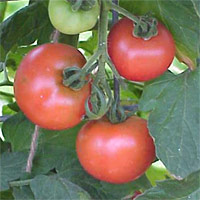Tomato

A favorite of home gardeners, tomatoes are easy to grow, and just a few plants will supply an abundant harvest.
About This Plant
With hundreds of varieties to choose from, and more being introduced every year, there is a tomato for every garden situation and every personal taste. The size of the fruit is no indication of plant size -- tiny " currant " tomatoes might grow on huge, vining (indeterminate) plants, while large "beefsteak" varieties can be found on more manageable bush (determinate) plants. Newer hybrid varieties have been bred for disease resistance, but don't overlook heirlooms that are famous for their rich flavors. By planting early-, mid-, and late-season varieties, you can extend the harvest.
Site Selection
Select a site with full sun and well-drained soil. In very hot climates, light afternoon shade may help prevent blossom drop. Prepare the garden bed by using a garden fork or tiller to loosen the soil to a depth of 12 to 15 inches, then mix in a 2- to 4-inch layer of compost.
Planting Instructions
If you don't purchase plants, start seeds indoors in flats or pots 6 to 7 weeks before the average last frost date, and set out transplants when the soil is warm and all danger of frost is past. Set up trellises, cages, or stakes at planting time. Dig planting holes 18 to 24 inches apart if you plan to stake or trellis the crops, 36 to 48 inches apart if the plants aren't trained. Pinch off two or three of the lower branches on the transplant and set the root ball of the plant well into the hole until the remaining lowest leaves are just above the soil surface. The plant will form additional roots along the buried stem. Water generously and keep the plants well watered for a few days.
Care
Provide an even supply of water all season. If staking or trellising, prune suckers to allow one or two central stems to grow on staked plants, two or three central stems for trellis systems. Apply a thick layer of organic mulch 4 or 5 weeks after transplanting. Contact your local County Extension office for controls of common tomato insect pests such as tomato hornworms and whiteflies.
Harvesting
For best flavor, harvest tomatoes when they are firm and fully colored. Fruits will continue to ripen if you pick them when they are half-ripe and bring them indoors, but the flavor is often better if you allow fruits to ripen on the vine.






 A favorite of home gardeners, tomatoes are easy to grow, and just a few plants will supply an abundant harvest.
A favorite of home gardeners, tomatoes are easy to grow, and just a few plants will supply an abundant harvest.